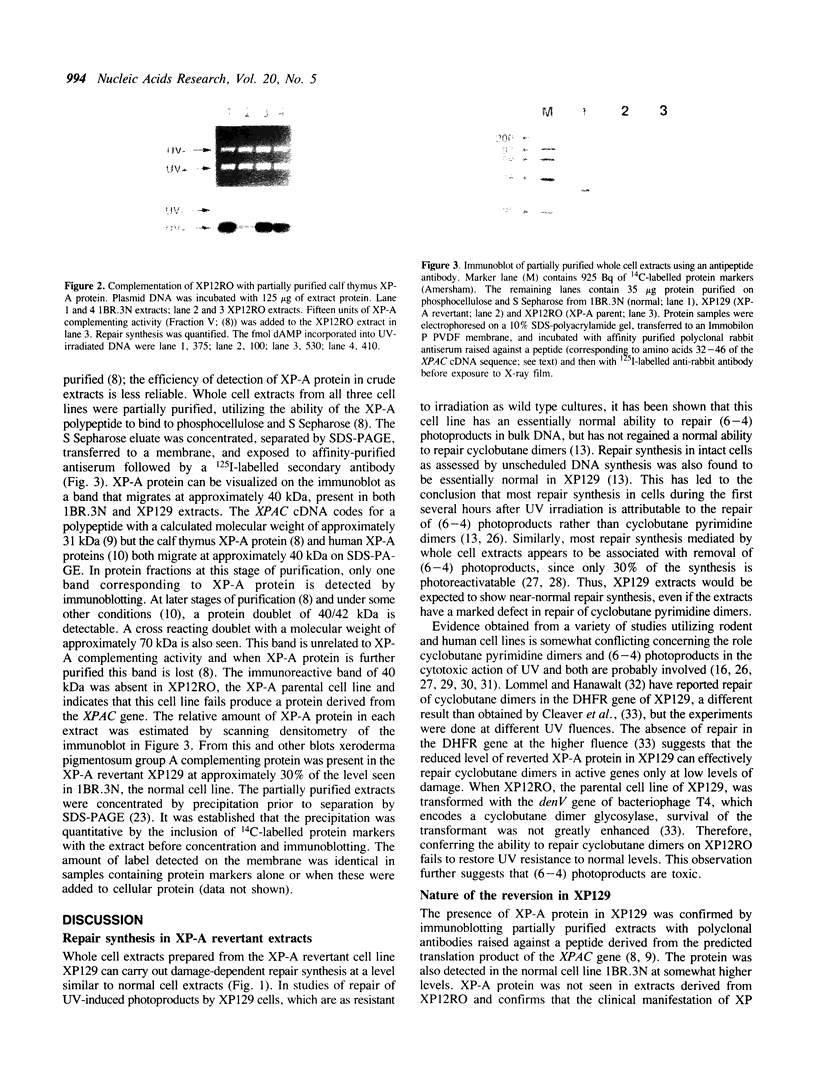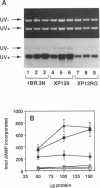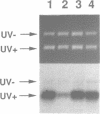Abstract
Cells derived from individuals with mutations in the xeroderma pigmentosum complementation group A gene (XP-A gene) are hypersensitive to UV light and have a severe defect in nucleotide excision repair of damaged DNA. UV-resistant revertant cell lines can arise from XP-A cells in culture. Cells of one such revertant, XP129, were previously shown to remove (6-4) photoproducts from irradiated DNA, but to have poor repair of cyclobutane pyrimidine dimers. To analyze the biochemical nature of the reversion, whole cell extracts were prepared from the SV40-immortalized fibroblast cell lines XP12RO (an XP-A cell line), the revertant XP129 (derived from XP12RO), and 1BR.3N (from a normal individual). The ability of extracts to carry out repair synthesis in UV-irradiated DNA was examined, and immunoblots were performed using antiserum that recognizes XP-A protein. XP12RO extracts exhibited a very low level of repair and no detectable XP-A protein, but repair activity could be conferred by adding purified XP-A protein to the reaction mixture. XP129 extracts have essentially normal repair synthesis consistent with the observation that most repair of UV-irradiated DNA by extracts appears to occur at (6-4) photoproducts. An XP-A polypeptide of normal size was present in XP129, but in reduced amounts. The results indicate that in XP129 a mutational event has converted the inactive XP12RO XP-A gene into a form which expresses an active XP-A protein.
Full text
PDF




Images in this article
Selected References
These references are in PubMed. This may not be the complete list of references from this article.
- Asahara H., Wistort P. M., Bank J. F., Bakerian R. H., Cunningham R. P. Purification and characterization of Escherichia coli endonuclease III from the cloned nth gene. Biochemistry. 1989 May 16;28(10):4444–4449. doi: 10.1021/bi00436a048. [DOI] [PubMed] [Google Scholar]
- Batanian J. R., Ledbetter S. A., Wolff R. K., Nakamura Y., White R., Dobyns W. B., Ledbetter D. H. Rapid diagnosis of Miller-Dieker syndrome and isolated lissencephaly sequence by the polymerase chain reaction. Hum Genet. 1990 Oct;85(5):555–559. doi: 10.1007/BF00194237. [DOI] [PubMed] [Google Scholar]
- Biggerstaff M., Robins P., Coverley D., Wood R. D. Effect of exogenous DNA fragments on human cell extract-mediated DNA repair synthesis. Mutat Res. 1991 May;254(3):217–224. doi: 10.1016/0921-8777(91)90059-x. [DOI] [PubMed] [Google Scholar]
- Broughton B. C., Lehmann A. R., Harcourt S. A., Arlett C. F., Sarasin A., Kleijer W. J., Beemer F. A., Nairn R., Mitchell D. L. Relationship between pyrimidine dimers, 6-4 photoproducts, repair synthesis and cell survival: studies using cells from patients with trichothiodystrophy. Mutat Res. 1990 Jan;235(1):33–40. doi: 10.1016/0921-8777(90)90020-6. [DOI] [PubMed] [Google Scholar]
- Cleaver J. E., Cortés F., Lutze L. H., Morgan W. F., Player A. N., Mitchell D. L. Unique DNA repair properties of a xeroderma pigmentosum revertant. Mol Cell Biol. 1987 Sep;7(9):3353–3357. doi: 10.1128/mcb.7.9.3353. [DOI] [PMC free article] [PubMed] [Google Scholar]
- Cleaver J. E. Defective repair replication of DNA in xeroderma pigmentosum. Nature. 1968 May 18;218(5142):652–656. doi: 10.1038/218652a0. [DOI] [PubMed] [Google Scholar]
- Cleaver J. E., Jen J., Charles W. C., Mitchell D. L. Cyclobutane dimers and (6-4) photoproducts in human cells are mended with the same patch sizes. Photochem Photobiol. 1991 Sep;54(3):393–402. doi: 10.1111/j.1751-1097.1991.tb02033.x. [DOI] [PubMed] [Google Scholar]
- Cleaver J. E., Rose R., Mitchell D. L. Replication of chromosomal and episomal DNA in X-ray-damaged human cells: a cis- or trans-acting mechanism? Radiat Res. 1990 Dec;124(3):294–299. [PubMed] [Google Scholar]
- De Weerd-Kastelein E. A., Keijzer W., Bootsma D. Genetic heterogeneity of xeroderma pigmentosum demonstrated by somatic cell hybridization. Nat New Biol. 1972 Jul 19;238(81):80–83. doi: 10.1038/newbio238080a0. [DOI] [PubMed] [Google Scholar]
- Hoeijmakers J. H., Bootsma D. Molecular genetics of eukaryotic DNA excision repair. Cancer Cells. 1990 Oct;2(10):311–320. [PubMed] [Google Scholar]
- Loeb L. A. Mutator phenotype may be required for multistage carcinogenesis. Cancer Res. 1991 Jun 15;51(12):3075–3079. [PubMed] [Google Scholar]
- Lommel L., Hanawalt P. C. The genetic defect in the Chinese hamster ovary cell mutant UV61 permits moderate selective repair of cyclobutane pyrimidine dimers in an expressed gene. Mutat Res. 1991 Sep;255(2):183–191. doi: 10.1016/0921-8777(91)90052-q. [DOI] [PubMed] [Google Scholar]
- Manley J. L., Fire A., Samuels M., Sharp P. A. In vitro transcription: whole-cell extract. Methods Enzymol. 1983;101:568–582. doi: 10.1016/0076-6879(83)01038-1. [DOI] [PubMed] [Google Scholar]
- Mayne L. V., Priestley A., James M. R., Burke J. F. Efficient immortalization and morphological transformation of human fibroblasts by transfection with SV40 DNA linked to a dominant marker. Exp Cell Res. 1986 Feb;162(2):530–538. doi: 10.1016/0014-4827(86)90356-3. [DOI] [PubMed] [Google Scholar]
- Miguel A. G., Daisey J. M., Sousa J. A. Comparative study of the mutagenic and genotoxic activity associated with inhalable particulate matter in Rio de Janeiro air. Environ Mol Mutagen. 1990;15(1):36–43. doi: 10.1002/em.2850150106. [DOI] [PubMed] [Google Scholar]
- Mitchell D. L., Haipek C. A., Clarkson J. M. (6-4)Photoproducts are removed from the DNA of UV-irradiated mammalian cells more efficiently than cyclobutane pyrimidine dimers. Mutat Res. 1985 Jul;143(3):109–112. doi: 10.1016/s0165-7992(85)80018-x. [DOI] [PubMed] [Google Scholar]
- Mitchell D. L., Nguyen T. D., Cleaver J. E. Nonrandom induction of pyrimidine-pyrimidone (6-4) photoproducts in ultraviolet-irradiated human chromatin. J Biol Chem. 1990 Apr 5;265(10):5353–5356. [PubMed] [Google Scholar]
- Mitchell D. L. The relative cytotoxicity of (6-4) photoproducts and cyclobutane dimers in mammalian cells. Photochem Photobiol. 1988 Jul;48(1):51–57. doi: 10.1111/j.1751-1097.1988.tb02785.x. [DOI] [PubMed] [Google Scholar]
- Mitchell D. L., Zdzienicka M. Z., van Zeeland A. A., Nairn R. S. Intermediate (6-4) photoproduct repair in Chinese hamster V79 mutant V-H1 correlates with intermediate levels of DNA incision and repair replication. Mutat Res. 1989 May;226(1):43–47. doi: 10.1016/0165-7992(89)90091-2. [DOI] [PubMed] [Google Scholar]
- Miura N., Miyamoto I., Asahina H., Satokata I., Tanaka K., Okada Y. Identification and characterization of xpac protein, the gene product of the human XPAC (xeroderma pigmentosum group A complementing) gene. J Biol Chem. 1991 Oct 15;266(29):19786–19789. [PubMed] [Google Scholar]
- Robins P., Jones C. J., Biggerstaff M., Lindahl T., Wood R. D. Complementation of DNA repair in xeroderma pigmentosum group A cell extracts by a protein with affinity for damaged DNA. EMBO J. 1991 Dec;10(12):3913–3921. doi: 10.1002/j.1460-2075.1991.tb04961.x. [DOI] [PMC free article] [PubMed] [Google Scholar]
- Royer-Pokora B., Haseltine W. A. Isolation of UV-resistant revertants from a xeroderma pigmentosum complementation group A cell line. 1984 Sep 27-Oct 3Nature. 311(5984):390–392. doi: 10.1038/311390a0. [DOI] [PubMed] [Google Scholar]
- Rydberg B., Spurr N., Karran P. cDNA cloning and chromosomal assignment of the human O6-methylguanine-DNA methyltransferase. cDNA expression in Escherichia coli and gene expression in human cells. J Biol Chem. 1990 Jun 5;265(16):9563–9569. [PubMed] [Google Scholar]
- Schultz R. A., Barbis D. P., Friedberg E. C. Studies on gene transfer and reversion to UV resistance in xeroderma pigmentosum cells. Somat Cell Mol Genet. 1985 Nov;11(6):617–624. doi: 10.1007/BF01534726. [DOI] [PubMed] [Google Scholar]
- Sibghatullah, Husain I., Carlton W., Sancar A. Human nucleotide excision repair in vitro: repair of pyrimidine dimers, psoralen and cisplatin adducts by HeLa cell-free extract. Nucleic Acids Res. 1989 Jun 26;17(12):4471–4484. doi: 10.1093/nar/17.12.4471. [DOI] [PMC free article] [PubMed] [Google Scholar]
- Tanaka K., Miura N., Satokata I., Miyamoto I., Yoshida M. C., Satoh Y., Kondo S., Yasui A., Okayama H., Okada Y. Analysis of a human DNA excision repair gene involved in group A xeroderma pigmentosum and containing a zinc-finger domain. Nature. 1990 Nov 1;348(6296):73–76. doi: 10.1038/348073a0. [DOI] [PubMed] [Google Scholar]
- Thielmann H. W., Popanda O., Edler L., Jung E. G. Clinical symptoms and DNA repair characteristics of xeroderma pigmentosum patients from Germany. Cancer Res. 1991 Jul 1;51(13):3456–3470. [PubMed] [Google Scholar]
- Thompson L. H., Mitchell D. L., Regan J. D., Bouffler S. D., Stewart S. A., Carrier W. L., Nairn R. S., Johnson R. T. CHO mutant UV61 removes (6-4) photoproducts but not cyclobutane dimers. Mutagenesis. 1989 Mar;4(2):140–146. doi: 10.1093/mutage/4.2.140. [DOI] [PubMed] [Google Scholar]
- Vuksanovic L., Cleaver J. E. Unique cross-link and monoadduct repair characteristics of a xeroderma pigmentosum revertant cell line. Mutat Res. 1987 Nov;184(3):255–263. doi: 10.1016/0167-8817(87)90024-1. [DOI] [PubMed] [Google Scholar]
- Wessel D., Flügge U. I. A method for the quantitative recovery of protein in dilute solution in the presence of detergents and lipids. Anal Biochem. 1984 Apr;138(1):141–143. doi: 10.1016/0003-2697(84)90782-6. [DOI] [PubMed] [Google Scholar]
- Wood R. D. Repair of pyrimidine dimer ultraviolet light photoproducts by human cell extracts. Biochemistry. 1989 Oct 17;28(21):8287–8292. doi: 10.1021/bi00447a005. [DOI] [PubMed] [Google Scholar]
- Wood R. D., Robins P., Lindahl T. Complementation of the xeroderma pigmentosum DNA repair defect in cell-free extracts. Cell. 1988 Apr 8;53(1):97–106. doi: 10.1016/0092-8674(88)90491-6. [DOI] [PubMed] [Google Scholar]





